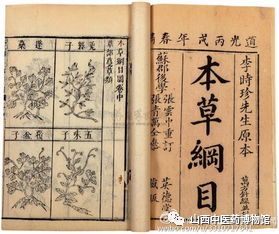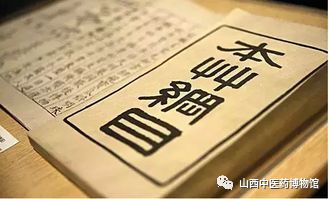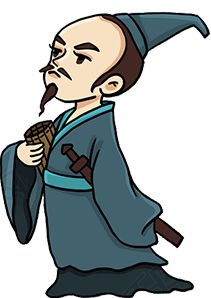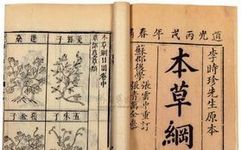The Compendium of Materia Medica has been published for centuries, and its academic value continues to shine brightly, becoming a shared scientific treasure for people around the world.

Li Shizhen was born in Qichun, Hubei. Both his grandfather and father were physicians. He abandoned Confucianism to pursue medicine and worked in the Imperial Medical Institute, actively engaging in drug research. He frequently visited the pharmacy and imperial medicine store, diligently comparing and identifying medicinal materials from across the country, collecting a vast amount of data. He also took the opportunity to peruse the rich collection of ancient texts in royal libraries, gaining access to a wealth of information about folk medicine and seeing many medicinal specimens that were usually hard to come by. This greatly broadened his horizons and enriched his knowledge, laying a solid foundation for compiling the Compendium of Materia Medica. After thirty years of hard work, Li Shizhen completed the Compendium of Materia Medica, which consists of 16 volumes and 52 chapters, totaling approximately 1.9 million words. The book includes 1,518 medicinal substances from various schools of materia medica, adding 374 new substances, for a total of 1,892, including 1,195 plant species. It also compiles 11,096 ancient prescriptions and folk remedies, with over 1,100 illustrations of medicinal forms. This great work absorbed the essence of previous materia medica texts, corrected past errors, supplemented deficiencies, and made many important discoveries and breakthroughs. It not only addressed issues related to the methods and retrieval of medicinal substances but also reflected new insights into plant taxonomy and the ideas of biological evolution. The book systematically records knowledge about various medicinal substances, including corrections, nomenclature, collections, verifications, modifications, properties, indications, inventions, appendices, and additional prescriptions, detailing the history, morphology, and functions of the substances and formulas. Particularly noteworthy is the section on “inventions,” which mainly presents new discoveries and experiences in the observation, research, and practical application of medicinal substances, further enriching the knowledge of materia medica. The Compendium of Materia Medica is the most systematic and complete work of traditional Chinese medicine up to the 16th century.
In 1596, the Jinling edition of the Compendium of Materia Medica was published, causing a strong reaction both domestically and internationally. British biologist Charles Darwin referred to the Compendium of Materia Medica as the “Encyclopedia of 1596.” In 2011, the Jinling edition was included in the World Memory Register. From the 17th century onwards, the Compendium of Materia Medica was translated into various foreign languages, having a wide-ranging impact in Japan, Korea, some Western European countries, and the United States, making a significant contribution to the world of medicine. This article provides an overview of the dissemination and impact of the Compendium of Materia Medica overseas in chronological and geographical order.
The Compendium of Materia Medica in Japan
In 1603, shortly after the Jiangxi edition of the Compendium of Materia Medica was published, scholar Hayashi Razan obtained a copy from the trading port of Nagasaki and presented it to Tokugawa Ieyasu, the founder of the Edo shogunate, where it was revered as the “Divine Lord’s Copy.” In 1637, the earliest Japanese edition of the Compendium of Materia Medica was published in Kyoto, annotated with Japanese kana alongside the Chinese text, making it the first Japanese version. Soon after, a “materia medica craze” swept through Japanese academia, leading to the publication of numerous works on Chinese pharmacology and materia medica, with many based on selections, supplements, annotations, and expansions of the Compendium of Materia Medica. Statistics show that over 30 specialized works studying the Compendium of Materia Medica were published in the 250 years prior to the 1870s.
The rapid spread and high regard for the Compendium of Materia Medica in Japan can be attributed to several profound reasons: politically, the Tokugawa shogunate vigorously promoted economic growth and rewarded scientific and cultural endeavors, greatly stimulating the demand for Chinese medical texts; economically and technologically, the flourishing trade and advanced printing techniques between China and Japan facilitated the import of Chinese medicinal materials and the translation and publication of books; in terms of national conditions, Japan’s scarcity of medicinal resources led the shogunate to encourage domestic development of medicinal sources and the establishment of medicinal gardens, for which the Compendium of Materia Medica provided abundant information for the introduction, cultivation, and modification of medicines; and in terms of national character, the Japanese people are adept at absorbing the essence of foreign scientific and cultural achievements, so the highly regarded Compendium of Materia Medica naturally spread rapidly upon its introduction to Japan.
The Tokugawa family, as the shogunate’s leaders, held the Compendium of Materia Medica in high esteem, often keeping it at hand for reference. This was the initial situation of the Compendium’s introduction to Japan. Subsequently, various editions, including the Jiangxi summer edition and the Hangzhou Qian edition, were introduced to Japan, and today, copies of the Ming and Qing editions of the Compendium of Materia Medica can still be found in libraries and private collections across Japan. The Japanese people are skilled at adapting foreign cultures for their own use. In the early stages of its introduction, some Japanese scholars wrote works tailored to the characteristics of the Japanese people to facilitate reading and research. Additionally, the Japanese not only studied the original text of the Compendium of Materia Medica but also continuously reprinted and translated it. Among them, Nakagawa Tokushin (also known as Yakuan) published the “Yamato Materia Medica” in 1709. This work is considered the foundational text of Japanese materia medica and botany, and it represents the greatest achievement of the Compendium of Materia Medica’s dissemination in Japan. The classification method of the “Yamato Materia Medica” is generally similar to that of the Compendium of Materia Medica but is more practical and encyclopedic in nature. Its content is not limited to a simple explanation of the Compendium but is based on Yakuan’s own field investigations and experiments, emphasizing practicality. Unfortunately, the school of materia medica led by Yakuan did not have successors. Later, various schools of materia medica emerged in Japan, primarily forming the Kyoto and Edo schools. The founder of the Kyoto school was Inoue Jaku-sui, who devoted his life to studying the Compendium of Materia Medica and used it as a textbook to educate students. The Kyoto school is the orthodox school of materia medica research in Japan, having been little influenced by Western botanical studies. In their research, they did not critically engage with Chinese materia medica. On the other hand, the Japanese, known for their strong independence, used the practical spirit of the Compendium of Materia Medica as a mirror to conduct field investigations, collections, and experiments on their own natural resources, accumulating a wealth of knowledge in Japanese materia medica, exemplified by Ono Ransan. The Edo school of materia medica originated during the Edo period, centered around materia medica scholars promoted and trained by the shogun Yoshimune. They conducted practical and applied research in materia medica in response to the shogunate’s policies on promoting production and industry.
Since the 17th century, when Li Shizhen’s Compendium of Materia Medica was introduced to Japan, it has been highly valued by Japanese scholars. Numerous scholars have reprinted, published, taught, annotated, and translated it, or conducted field investigations, identifications, and cultivation of the medicinal substances recorded in the book, inheriting this work and advancing Japanese indigenous materia medica to new heights.
The Compendium of Materia Medica in Korea
China and Korea have had frequent scientific and cultural exchanges since ancient times, mutually learning from each other and contributing to the joint development of science and culture. According to currently available historical materials, the Compendium of Materia Medica was introduced to Korea around the early 18th century. In the 38th year of King Sukjong’s reign (1712), the “Books Purchased” section of the “Old Farmer’s Diary” mentions the title of the Compendium of Materia Medica, which was likely brought back by a Korean envoy from Beijing. Subsequently, Chinese editions of the Compendium of Materia Medica were gradually introduced to various parts of Korea. From the reign of King Yeongjo (1725–1776) and King Jeongjo (1777–1800), the Compendium of Materia Medica became an important reference for Korean physicians, and its influence became particularly significant by the end of the Joseon Dynasty. Among the most notable Korean medical texts citing the Compendium of Materia Medica is the “New Compilation of Medical Prescriptions,” which systematically compiles commonly used prescriptions of the time, extensively citing the Compendium of Materia Medica, “Introduction to Medicine,” and other traditional Chinese medical texts.

During the reign of King Cheoljong (1801–1834), Korean physician Hong Deok-ju (Shinbeok) edited the supplementary prescriptions from the Compendium of Materia Medica into fifty volumes, titled “Unified Compendium of Materia Medica,” which was published in Uiju. At the same time, Seo Yu-kyu (1764–1845) compiled a monumental work titled “Sixteen Records of Natural Economy and Botany” in 113 volumes and 52 books, which is a vast compendium of Korean natural economy and botany, divided into sixteen records including books, fishing, cooking, and nurturing. In the fifth year of King Gojong’s reign (1868), Hwang Do-won published the “Song of Medicinal Properties,” which can be seen as a standalone materia medica work and a supplement to the “New Compilation of Medical Prescriptions.” This book classifies medicinal substances according to the more advanced natural classification method found in the Compendium of Materia Medica, extensively quoting from the main text for further explanation. Another notable Korean physician, Ji Yang-yeong (also known as Gongcheol, 1885–1935), who was well-versed in both Eastern and Western medicine, authored the “Essence of Materia Medica,” which is an excerpt of the Compendium of Materia Medica, mainly collecting its essence and providing commentary, with manuscripts still in circulation today. Since the Compendium of Materia Medica was introduced to Korea in the 18th century, it has had a positive impact on the development of Korean medicine for over 200 years, receiving acclaim and popularity. The dissemination of the Compendium of Materia Medica in Korea is a significant episode in the history of scientific and technological exchanges between China and Korea.
After the Compendium of Materia Medica spread to Japan and Korea, it opened new horizons for the medical and botanical communities in those countries. The Compendium of Materia Medica had a significant impact on the classification of materia medica in both Japan and Korea. The Japanese medical community focused on the verification and identification of medicinal substances when studying the Compendium of Materia Medica, while the Korean medical community emphasized simplicity and practicality, conducting extensive compilations and simplifications of the original text.
The Compendium of Materia Medica in Europe
By the 18th century at the latest, the Compendium of Materia Medica had reached Europe. In 1887, the British Museum’s catalog of Chinese books included records of the 1603 Jiangxi edition, the 1655 Zhang Yunzong edition, and the 1826 Yingde Hall edition of the Compendium of Materia Medica. Western missionaries in China were the first to notice the Compendium of Materia Medica and introduced it to Europe.
After the Compendium of Materia Medica traveled west, it first attracted the attention of Western sinologists and Westerners in China who understood Chinese. Through translation and introduction, it sparked interest among scholars from various fields in the West. According to British historian Joseph Needham, French physician Jean-Baptiste van der Monde obtained the Compendium of Materia Medica while practicing medicine in Macau in 1732, collecting 80 mineral specimens based on the medicinal substances listed in the book. Subsequently, with the help of Chinese individuals, he compiled materials titled “Medicinal Substances of Water, Fire, Metal, and Stone in the Compendium of Materia Medica,” which is an incomplete translation of the Compendium. A century later, French sinologist Pierre de la Croix took an interest in these mineral specimens and had them analyzed, leading to the full publication of the French translation of the mineral section of the Compendium of Materia Medica in 1732.
The first European publication of an excerpt from the Compendium of Materia Medica appeared in the 1735 French edition of “General History of the Chinese Empire” (Zhonghua Diguo Quanzhi). At that time, many European readers who could not understand Chinese first learned about the Compendium of Materia Medica through this famous work. A “China craze” emerged in Europe at that time. The publication of this book immediately caused a sensation in Europe, attracting attention from various sectors. In 1736, the “General History of the Chinese Empire” was translated into English, titled “A General History of China.” From 1747 to 1949, the French version of the “General History of the Chinese Empire” was translated into German, titled “General History of China and the Great Tartary.” Between 1774 and 1777, the “General History of the Chinese Empire” was translated into Russian. In the early 19th century, a young Frenchman named Le Mousseau, while visiting the Paris Forest Monastery, was captivated by the numerous illustrations of animals and plants in the Compendium of Materia Medica, prompting him to self-study Chinese. After five years of hard work, he overcame the language barrier and submitted a research paper on the Compendium of Materia Medica and Chinese medicine to the medical department of the University of Paris in 1813, which received high praise. Le Mousseau was thus awarded a doctorate, marking the beginning of Western academic recognition of the Compendium of Materia Medica. From then on, research on the Compendium of Materia Medica and Chinese materia medica began in Europe during the 19th century, leading to a plethora of papers and works related to materia medica. Russian scholar Beller, a renowned researcher of the Compendium of Materia Medica in the late 19th century, was proficient in Latin and several Western European languages, having spent many years in China and being well-versed in Chinese literature and history. He dedicated himself to botany and the history of Sino-Western exchanges. Around 1884, he published “Chinese Plant Studies: Essays on Chinese Botany as Seen in Chinese Classics.” This work is divided into three parts: an introduction and bibliographic summary, plants in Chinese classics, and studies of botany in ancient Chinese materia medica. Additionally, Beller published “Early European Studies on Chinese Plants” and an expanded version of “The History of Botanical Discoveries by Europeans in China,” as well as “Research and Commentary on Chinese Botanical Works.” Beller held the Compendium of Materia Medica in high regard, stating, “The resolution of certain botanical issues greatly depends on the study of Chinese botanical texts, particularly regarding the origins of cultivated plants, which is why this article draws heavily from the Compendium of Materia Medica and other Chinese texts.”
Since the 18th century, as the Compendium of Materia Medica was gradually introduced to the West, it opened new perspectives for the medical and botanical communities in various Western countries. They discovered many valuable resources from the Chinese medicinal treasure trove, elevating the study of materia medica to a new level.
The Compendium of Materia Medica in the United States
Since the 19th century, American scholars have also begun to study the Compendium of Materia Medica. Today, the Library of Congress in the United States still holds the 1596 Jinling edition and the 1603 Jiangxi edition of the Compendium of Materia Medica. The Jinling edition was initially introduced to Japan from China and then brought to the United States from Japan. This Jinling edition is not only an original edition but has also been reviewed by the famous Japanese materia medica scholar Mori Ritsu (1807–1885), making it extremely valuable. Today, many university libraries in the United States have copies of the Ming and Qing editions of the Compendium of Materia Medica. This indicates that since the 18th century, the Compendium of Materia Medica has spread throughout various regions of the United States.
Since the 20th century, Americans have also begun extensive research on the Compendium of Materia Medica. An American named Mills, while in Korea, collaborated with Korean colleagues to translate the Compendium of Materia Medica into manuscript form (over 40 volumes), which was later comprehensively introduced and studied in English by British scholar Ebon and Chinese scholars based on Mills’ work. This translation provided a shortcut for Western readers to understand the Compendium of Materia Medica. Although it is not a complete English translation, it essentially introduces the essence of the original work and is considered an excellent work for studying the Compendium of Materia Medica. American-German sinologist Raufel described it as a “comprehensive and famous Compendium of Materia Medica.” In the 1970s, many Western scholars began to study Li Shizhen and the Compendium of Materia Medica. Notable American historian Joseph Needham, in collaboration with Cooper, published a lengthy article titled “Medicinal Substances in the Human Body” in 1973, stating, “To discuss the eight substances produced in the human body, we must refer to Li Shizhen’s Compendium of Materia Medica from 1596 to explain their products and applications. This book remains a standard reference for traditional physicians.” In the same year, Needham also published a 14-volume “Dictionary of Biographies of Scientists,” writing a lengthy biography of Li Shizhen, providing a comprehensive introduction to his life and the Compendium of Materia Medica, making it one of the more complete biographies of Li Shizhen. This indicates that the Compendium of Materia Medica has had a certain impact on American academia, and the traditional Chinese culture it represents has attracted the attention of the American people.
Since its publication, the Compendium of Materia Medica has maintained its academic value and has become a shared scientific treasure for people around the world. British historian Joseph Needham commented on the Compendium of Materia Medica in his “History of Chinese Science and Technology”: “Undoubtedly, the greatest scientific achievement of the Ming Dynasty is Li Shizhen’s work, the Compendium of Materia Medica, which stands as a pinnacle in materia medica literature. To this day, this great work remains an inexhaustible source of knowledge for studying the history of chemistry and other sciences in Chinese culture.”

◉
●
◉
端
午
佳
节


 Experience Traditional Chinese Medicine Culture, Observe the Beauty of Nature
Experience Traditional Chinese Medicine Culture, Observe the Beauty of Nature
Discuss the Path of Health Preservation, Appreciate the Style of Jin Merchants
Welcome to Follow the Official WeChat of the Shanxi Traditional Chinese Medicine Museum
Opening Hours: Daily 9:00 AM – 5:00 PM
Address: No. 1, Guiling Mountain Villa, Taigu County, Shanxi Province
Reservation Phone: 0354-6139130 ext. 6101


